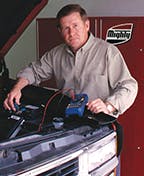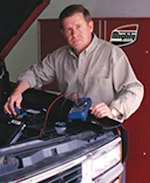A low oil pressure message/light is becoming a common complaint on 2007-2016 GM vehicles equipped with a V8 engine and active fuel management (AFM), which is sometimes referred to as displacement on demand (DOD). These symptoms often occur with no indication of a low oil pressure condition such as engine related noises.
Some technicians replace the oil pressure sensor in a futile attempt to eliminate the low oil pressure message. When this procedure fails to solve the problem, they often assume oil pump related issues are at fault or serious engine related problems have occurred. They may recommend some major engine repairs, which would not eliminate the mentioned symptoms.
In some cases, the customer encounters the low oil pressure message and has the oil and filter changed in an effort to correct the symptom. When this fails, the vehicle is often sent to the dealer for further evaluation. Familiar with the symptom and solution, the technician replaces the oil pressure sensor and a filter screen positioned beneath the sensor, which eliminates the low oil pressure message.
Unfortunately, some customers are told the condition was due to the aftermarket oil filter and the incorrect lubricant installed in their vehicle. Naturally, the vehicle owner gets upset and approaches the lube shop requesting compensation for the cost of the repairs. And he will be hesitant to let the lube shop service his vehicle in the future, as he has been convinced they created the problem.
When the mentioned filter screen becomes restricted with debris/sludge, it restricts the oil supply to the oil pressure sensor, resulting in a low oil pressure warning/message. The screen (see illustration) is actually a filter for the valve lifters on those GM applications equipped with AFM. The purpose of the filter screen is to help control contamination that can affect the AFM hydraulic system by filtering the oil that flows through the valve lifter oil manifold and its related solenoids.
GM has identified the following vehicles (see Affected Vehicles below) equipped with AFM as potential candidates for the mentioned low oil pressure message. GM states that some customers may complain of a low oil pressure message on the dash accompanied with a diagnostic code PO521. When diagnosing with a Tech 2 or equivalent and the oil pressure parameter is low but the oil pressure is normal at the oil filter housing, inspect the AFM valve lifter oil filter screen (located beneath the oil pressure sensor) for evidence of sludge. A contaminated filter screen can restrict the oil flow to the oil pressure sensor. If the filter screen is plugged, it can be cleaned with brake cleaner and low air pressure. Most elect to replace the filter screen, as it is a low cost item. I just purchased one for $6.57. Replacement of the filter screen can be performed without removing the intake manifold, as recommended by the vehicle manufacturer. It will require some basic tools such as a ratchet, socket, short extension, wiggle joint, patience, band aids and forgiveness for some of the comments you will make during the exercise.
With sludge forming on the AFM valve lifter filter screen, we can only question some of the recommended extended oil drain intervals. Can the vehicles be driven the extended mileage and still remain free of sludge deposits? Considering that, how much is really being saved in car maintenance? The cost of an oil and filter change is minor when compared to engine damage due to contamination and inadequate lubrication. Has the technology reached a level that vehicles can be driven for extended oil drain intervals and remain free of contaminants, or is this marketing strategy to sell vehicles by promoting lower maintenance cost? Operating a vehicle for 12,000-15,000 miles or changing the oil once a year is not a maintenance schedule I would perform on one of my vehicles.
Affected Vehicles • 2007 Cadillac Escalade built before April 1, 2006, with a 6.2L L92 engine. These engines were built with AFM hardware but the AFM system was disabled. • 2009 Buick LaCrosse Super, Allure Super (Canada only) • 2005-2007 Buick Rainier • 2007-2016 Cadillac Escalade • 2010-2016 Chevrolet Camaro SS • 2014-2016 Chevrolet Corvette • 2007-2016 Chevrolet Avalanche, Silverado, Suburban, Tahoe • 2007-2009 Chevrolet Impala • 2005-2009 Chevrolet TrailBlazer • 2007 Chevrolet Monte Carlo • 2007-2016 GMC Sierra, Yukon • 2005-2009 GMC Envoy • 2007-2008 Pontiac Grand Prix • 2008-2009 Pontiac G8 • 2005-2009 Saab 97X • With active fuel management (AFM) V8 engine RPO: L76, L77, L83, L86, L94, L99, LC9, LFA, LH6, LMG, LS4, LT1, LT4, LY5, LV3
Oil Pressure Loss During Lube Service While it is not a common problem, a technician can encounter a loss of oil pressure when replacing the oil filter while performing a lube service. The condition occurs when the oil is drained from the engine and air becomes trapped on the suction side of the oil pump promoting cavitation and a loss of oil pressure. The replacement oil filter often gets blamed for this encounter when the condition was actually the introduction of air into the system. Installing a second oil filter (often another brand) often gets credit for restoring the oil pressure when the actual solution was the release of the trapped air.
Priming the system can often be achieved by first disabling and preventing the engine from starting. With the oil filter gasket lightly touching the filter mounting base, crank the engine over in 20 second intervals (to prevent starter from overheating) until oil appears at the oil filter gasket, then tighten the filter. Further, if the application has a vertical mounted oil filter, filling the oil filter with oil can assist in restoring the oil pressure. Prior to installing the filter, squirt some oil into the oil filter mounting base inlet. Start the engine and check for oil pressure.
On earlier vehicles with camshaft driven oil pumps, pulling the distributor and priming the oil pump with a drill is one method of restoring the oil pressure. We often used this technique following an engine overhaul, prior to starting the engine for the first time.
Oil Pump Failure Any condition in the oil pump which allows the pressure regulating valve to stick will result in a pressurization problem. If the valve sticks in the open position, the oil returns to the suction side of the oil pump, resulting in a low or no oil pressure condition. If the valve sticks in the closed position an over pressurization condition can occur, causing the filter to become distorted or the gasket/seal to dislodge, promoting leakage. The technician and the vehicle are usually well lubricated when this occurs.
GM has encountered numerous oil pump failures with the 5.3L engines produced from 2007-2013, resulting in a loss of oil pressure due to sticking pressure regulating valves. On these engines, the oil pump is mounted on the front of the engine and is driven off the crankshaft at twice the speed of a camshaft driven pump. The pump is operating on unfiltered oil, therefore any debris/sludge in the oil can restrict the movement of the pressure regulating valve in the oil pump, causing it to stick.
Two additional areas that should be considered on any application when dealing with low or no oil pressure: 1. A restricted inlet screen on the pickup tube in the oil pan blocking the oil flow. 2. If the o-ring that seals the pickup tube to the oil pump is not properly sealed, cavitation can occur, resulting in a low or no oil pressure condition.
Timely vehicle maintenance is imperative in making certain the engine remains free of contaminants that can cause lubrication-related issues. Sludge and debris can result in some catastrophic engine failures.






